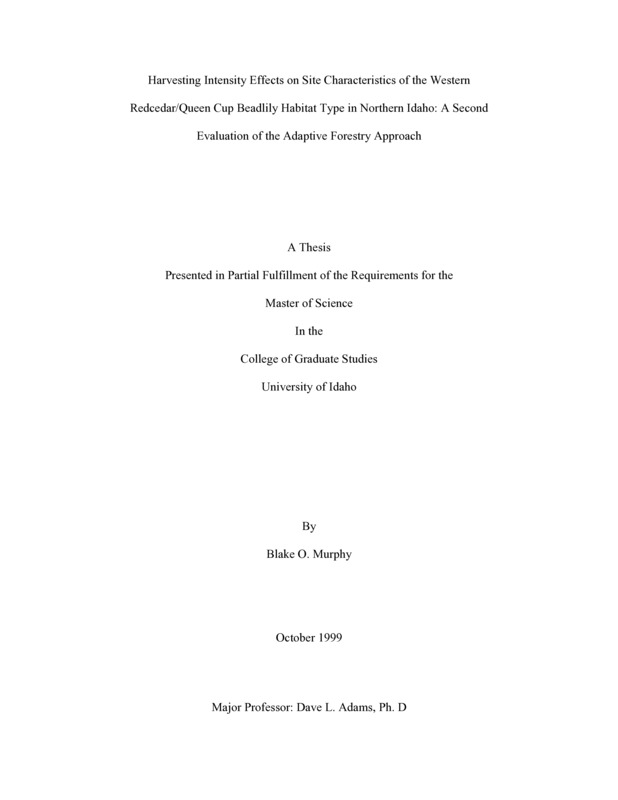PDF PREVIEW
Harvesting Intensity Effects on Site Characteristics of the Western Redcedar/Queen Cup Beadlily Habitat Type in Northern Idaho: A Second Evaluation of the Adaptive Forestry Approach Item Info
Download Preview PDF
Please note: PDF file may not be complete document.
- Title:
- Harvesting Intensity Effects on Site Characteristics of the Western Redcedar/Queen Cup Beadlily Habitat Type in Northern Idaho: A Second Evaluation of the Adaptive Forestry Approach
- Creator:
- Murphy, Blake O.
- Date Created:
- 1999-10
- Description:
- Two studies were conducted on the University of Idaho Experimental Forest to evaluate the effects of adaptive forestry methods on site characteristics that influence site productivity. Adaptive forestry is a forest management philosophy that addresses scientific and social concerns about logging, especially in old growth forests, while maintaining employment opportunities and production of forest products that society demands. The first study was implemented during 1991 and 1992 (AF92) and collected pre- and post-harvest measurements on overstory and understory vegetation, downed woody debris (DWD), forest floor and fuel depths, soil strength, and soil pH. In 1998 and 1999, the second study (AF98) re-measured these characteristics. Additional data collected and analyzed in AF98 included total soil nitrogen, mineralizable nitrogen, and soil organic matter. Data analyses were conducted with one way analysis of variance (ANOVA). One-sided P-values less than 0.05 were considered significant. Four treatment units with similar aspect and elevation were established in the Thuja plicata/clintonia uniflora habitat type: an undisturbed control, a traditional clearcut, an adaptive forestry free thinning, and an adaptive forestry seed-tree cut. After harvests, the regenerative treatments (i.e. seed-tree and clearcut units) were burned under prescription and planted with container-grown conifer seedlings. Tree regeneration and survival was higher in the seed-tree unit (1,500 trees per acre(tpa)) than in the clearcut (120 tpa). Understory vegetation was 78%, 60%, 31%, and 2% for the clearcut, seed-tree, thinning, and control, respectively. Forest floor depth was significantly different between treatments. Significant increases in pH were observed in the forest floor of the clearcut and seed-tree units. No significant differences were observed between treatments for total nitrogen and quantity of organic matter. Significantly less mineralizable nitrogen was present in the forest floor and top 10cm of mineral soil in all harvested units when compared to the control. Mineralizable nitrogen in the forest floor was reduced in the clearcut, seed-tree, and thinning by 32%, 33%, and 33%, respectively. Mineralizable nitrogen in the top 10cm of mineral soil was reduced in the clearcut, seed-tree, and thinning by 30%, 24%, and 25%. Mineralizable nitrogen was not significantly different between treatments in the mineral soil at 10-30cm depth. Significant differences in soil strength were observed at 5cm and 10cm depths. At the 5cm depth, increases over control levels were 6.6%, 3.1%, 1.7% for the clearcut, seed-tree, and thinning units, respectively. At the 10cm depth, increases over control levels were 10.4%, 3.3%, and 2.9% for the clearcut, seed-tree, and thinning units. Of the characteristics examined, mineralizable nitrogen and soil strength are the most probably sources of reduced long-term productivity. Adaptive forestry practices reduced harvesting impacts on soil strength, but mineralizable nitrogen was similarly altered in both adaptive forestry and traditional clearcut units. Continued assessment of these site characteristics at 5-year intervals will assist in determining amelioration rates and provide further insight into the benefits and shortcomings of adaptive forestry practices.
- Document Type:
- Thesis
- Library Call Number:
- SD538.2.I2M87
- Subjects:
- Big Meadow Creek western redcedar queen cup beadlily adaptive forest management adaptive management adaptive forest management harvesting intensity silviculture
- UIEF Unit:
- Big Meadow Creek
- Section:
- NE 1/4 S22, NW 1/4 S23
- Township:
- T40N
- Range:
- R4W
- Location:
- UIEF; Big Meadow Creek
- Latitude:
- 46.799488
- Longitude:
- -116.812869
- Department:
- Department of Forest Resources
- Type:
- Text
- Format:
- application/pdf
Source
- Preferred Citation:
- "Harvesting Intensity Effects on Site Characteristics of the Western Redcedar/Queen Cup Beadlily Habitat Type in Northern Idaho: A Second Evaluation of the Adaptive Forestry Approach", UIEF Research Exchange, University of Idaho Library Digital Collections, https://www.lib.uidaho.edu/digital/uief/items/uief_0057.html
Rights
- Rights:
- In copyright, educational use permitted.
- Standardized Rights:
- http://rightsstatements.org/vocab/InC-EDU/1.0/

